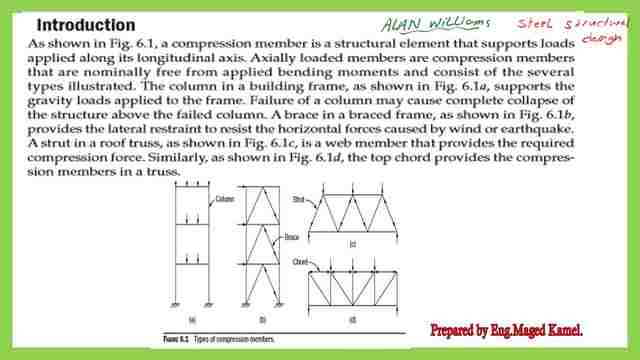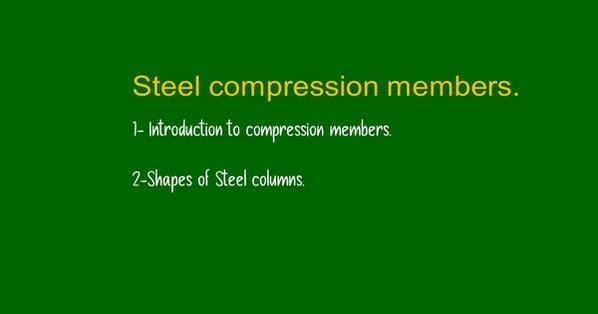Steel columns and Euler’s formula and k factors.
Introduction to Compression members. Euler’s formula gives a relation between the load-carrying capacity of the columns and their slenderness ratio, the slenderness ratio of height to the radius of gyration, the higher the slenderness ratio the lower load carry capacity.
According to Euler’s formula, the critical stress for a column can be evaluated as Fe=π^2 EI/(L/r)^2, where KL/r is called the slenderness ratio, K is the effective length factor, Fe is the critical stress, E is the modulus of elasticity.
The use of KL instead of L takes into consideration, the actual column length and support conditions. There are six conditions that columns may exist.
For each case a different k value is to be considered, for columns, these conditions are shown in the next picture, K factor cases for columns.
A detailed description of the Content of the lecture
Our subject will be the compression members, especially columns.
The first point. What is the definition of compression members?
The second point will be Euler’s equation the derivation of Euler’s equation.
The third point is what is buckling.
The fourth point is how to estimate the critical load?


Definition of the compression member.
From Prof Alan William’s book steel structure design.LRFD -ASD. for the definition of Compression member.
What is a compression member? A compression member is a structural member that carries loads along its longitudinal axis.
Usually, the compression member is free from the effect of the bending moment.
He explored the different types of compression members, for instance, columns, in a framed structure. If you have braced frames, then the bracing themselves are compression members, as for the truss.
The strut has a compression force, then is a compression member. As you can see in the figure, the strut has a compression force, then is a compression member on the right side as well as the diagonal member, and of course, the upper chord can be regarded as a compression member.


From Professor Varma’s lectures, the stress formula is computed. He defined compression members as the structural elements that are subjected to axial compressive forces loaded through the centroid.
The stress can be evaluated as the division of the compression load by the area.
But in reality, the situation might vary. it is rare how to have a concentric load.
Causes of additional stress to compression members.
1 -The accidental eccentricity of loading concerning the centroid.
2-Residual stresses in the member due to the fabrication process.
3- Member out of straightness which is called crookedness.
Members with compression and moment can be called beam-columns.


This is the pdf file used in the illustration of this post and the next post.
The next post-1a-Steel columns and Euler’s formula-part 2.
This is a link to an external resource-chapter 7– Concentrically Loaded Compression, Members

